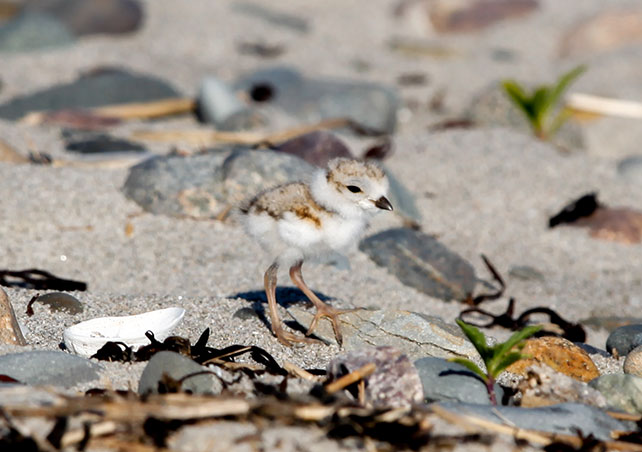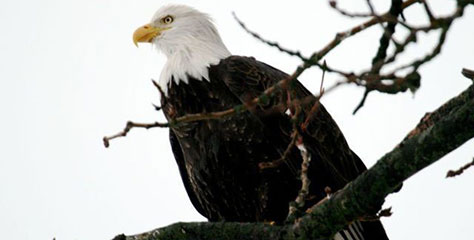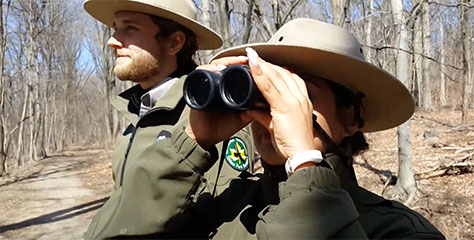Piping Plovers at the Rockaway Beach Endangered Species Nesting Area

Piping plovers are small shorebirds that, like many of us, like to spend their summers on the beach in NYC! Every summer, these endangered birds visit the Rockaways to nest and raise their chicks. But because they are very tiny and sand-colored, piping plovers are especially vulnerable to getting hurt. So every year, we fence off a special nesting area at the beach to help piping plovers and other vulnerable shorebirds nest and raise their chicks safely.
Learn more about piping plovers, why they are considered endangered, how we protect them, and how spending summers at Rockaway Beach help them thrive!
Piping Plover Season in New York City
When spring arrives, so does piping plover season! Piping plovers begin to arrive at their breeding grounds in New York City around March and stay there until August. Then they begin to migrate south to their winter grounds. Piping plovers nest on the beaches of the Rockaways, from Fort Tilden and Breezy Point all the way to Far Rockaway.
* Click on image to view larger
Appearance
Piping plovers are far tinier than your usual gull at Rockaway Beach. They are small, plump birds, typically 5.5-7.5 inches long (some are shorter than a blade of beachgrass!). They have a pale tan back, white underside, bright orange legs, and a stubby black beak. During the breeding season, their beak becomes orange with a black tip and a black band appears on their neck and forehead.
The hatched chicks look like tiny gray fluffs in the sand and when they get a little older, they look like tiny cotton balls!
If you happen to see one, please appreciate it from a distance and respect their nesting area. If you’d like a chance to see beach wildlife, like the piping plover, up close, check out our viewing binoculars on the boardwalk at Beach 22, Beach 44, and Beach 67.
Diet
Piping plovers forage along the shoreline for invertebrates, such as insects and small crustaceans. If you spot a piping plover, please don’t feed it. The Atlantic Ocean washes up on Rockaway Beach, bringing lots of healthy foods that piping plovers love. Help keep their food source clean and litter-free by taking your trash with you.
Threats to Piping Plovers
Piping plovers are considered an endangered species in New York State, and are listed as threatened at the federal level. Hunting of piping plovers for their feathers and for sport led to their near-extinction in the early 1900s. Although their populations were able to recover, they are still at risk. Their largest threats are predation, habitat damage and destruction, coastal development, and human disturbance. As of 2021, there were just 599 known breeding pairs in New York and New Jersey.
How NYC Parks Cares for Plovers and the Rockaway Beach Endangered Species Nesting Area
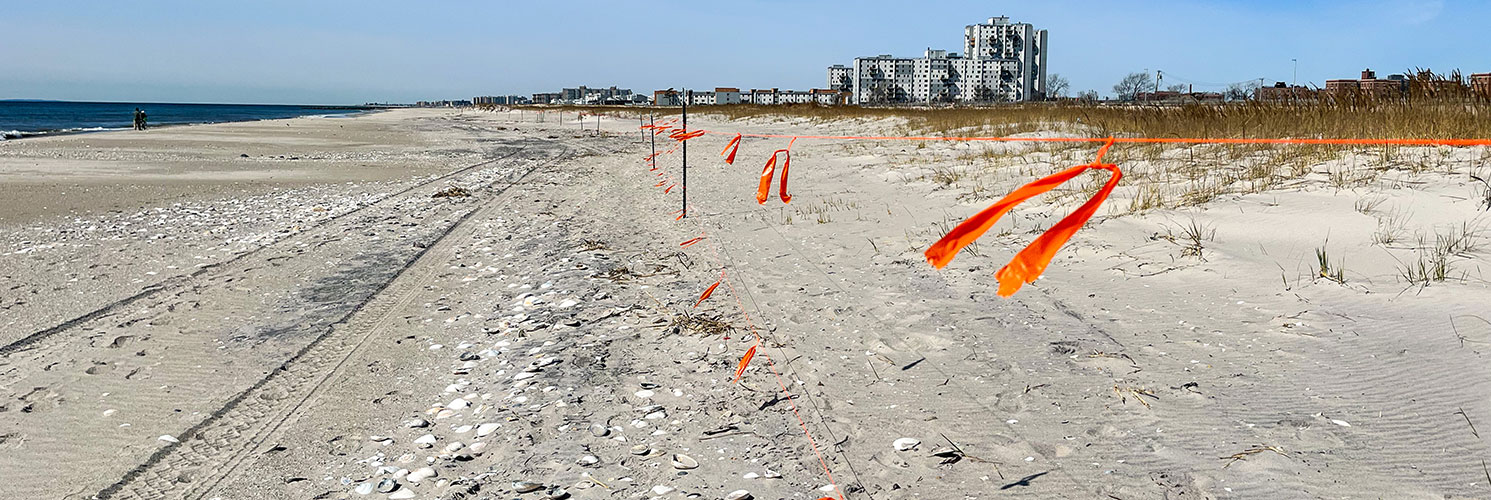
To help piping plovers thrive, NYC Parks has been managing the Rockaway Beach Endangered Species Nesting Area since 1996. Each summer, we protect one mile of Rockaway beach to allow piping plovers and other threatened shorebirds, such as American oystercatchers, black skimmers, common terns, and least terns, to nest and incubate their eggs undisturbed. The main breeding area includes the beach between Beach 38th Street and Beach 57th Street. Over the last few seasons, additional sites have been established both to the east and the west of this main area.
Our Wildlife Unit monitors the piping plovers on Rockaway Beach and their nesting sites for productivity and threats, according to the guidelines provided by the U.S. Fish & Wildlife Service. Records are kept regarding the number of plovers observed, the number of nesting pairs, the number of eggs in a clutch, the number of chicks, and the number of chicks that fledge. Observations are usually made from afar using binoculars and spotting scopes so as not to disturb the nesting plovers.
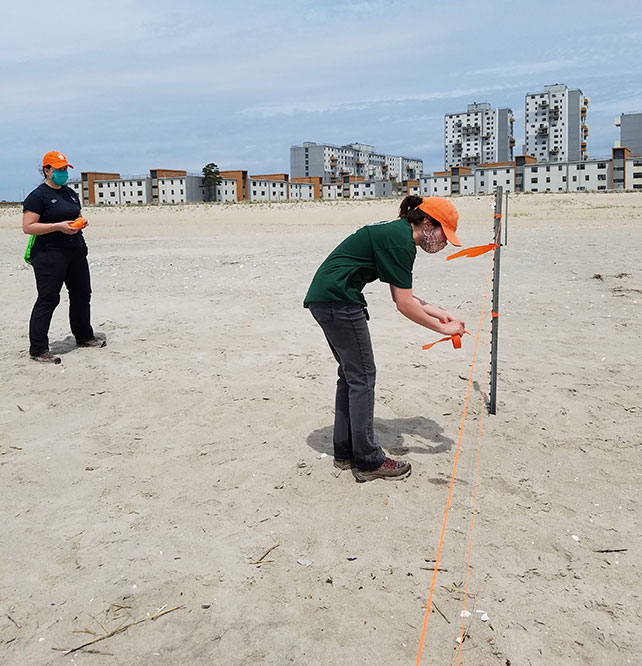
Explore the Rockaway Beach Endangered Species Nesting Area with Our Wildlife Unit
Coexisting with Piping Plovers in NYC
- Share the shore: Be mindful of fencing and signs protecting vulnerable plover nests and chicks and don’t disturb these sensitive areas.
- Keep your distance: Please observe and enjoy piping plovers from a distance, as incubating adults may leave their nests if humans get too close. In addition, although we protect one mile of beach for them to nest and raise their chicks, they sometimes wander away from the nesting areas to find more food. Please leave them be and enjoy them from a distance. Excessive human disturbance can interrupt their feeding. If you’d like a chance to see beach wildlife, like the piping plover, up close, check out our viewing binoculars on the boardwalk at Beach 22, Beach 44, and Beach 67.
- Take your trash with you: Be sure to take any trash off the beach with you, as food or garbage left on the beach attracts predators like rats, cats, and gulls that could harm piping plovers.
- Keep dogs leashed and away from piping plovers: Rockaway Beach rules prohibit dogs on the beach from Memorial Day weekend to October 1.
- Go fly a kite – somewhere else! Piping plovers may think a kite is an aerial predator, so keep kites at least 200 meters away from breeding plovers.
Explore Wildlife in New York City
New York City is home to an amazing abundance of wildlife from birds to eels and coyotes and deer. Learn more about their life here in the big city and how we help them thrive.
Wildlife in New York City
Discover which wildlife live in our city and find fun wildlife activities to learn more!
Wildlife Calendar
Use our wildlife calendar to learn about wildlife behavior by the month and where they thrive in our city.
Wildlife Programs
Join our Urban Park Rangers and friends as we head into the park to see and learn about wildlife.


